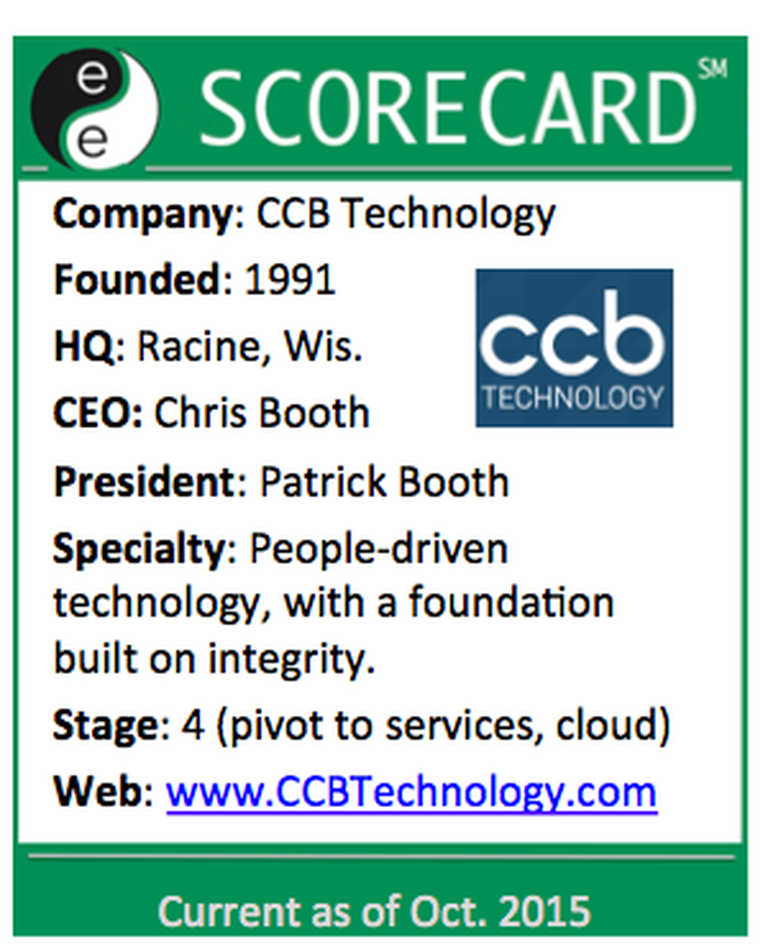
The current management organization is simply defined. Father Chris Booth founded CCB Technology in 1991 and remains CEO. Son Patrick Booth has spent more than a decade climbing the executive ranks at CCB, most recently becoming president in 2013. At some point the CEO title (and perhaps even company ownership) may shift to Patrick Booth. But again, that transition isn't guaranteed. Patrick Booth will need to work hard, and work smart, to earn the CEO title.
Here's a closer look at the Racine, Wis.-based company's multi-year journey -- and the father-son relationship that drives CCB Technology forward today. Plus, ChannelE2E explores the potential CEO transition that's still to come.
Side note for readers: CCB Technology has an extensive, talented team across business development, marketing, IT services, operations and sales. But for the purpose of this report, we focused in on Chris and Patrick Booth.
1991: Software Costs How Much?

Chris Booth launched Consistent Computer Bargains (CCB) in 1991 (rebranded as CCB Technology in 2015) with a clear mission and focus. His thesis: Nonprofits could rarely afford software at the time. Drive down the price to nonprofits, and software consumption overall would rise -- actually increasing revenues and profits for the software suppliers.
Booth was right. After much lobbying, Microsoft and several other big software providers embraced Booth's reasoning and nonprofit pricing models. Dozens of additional software vendors -- about 95 overall -- followed suit. CCB became the first company to provide discounted software pricing exclusively for nonprofits.
Chris Booth says much of the company's success was built on trust -- "If you don't have trust -- as a company advisor or as an individual -- then customers avoid you." Instead, customers won big. CCB believes it has saved over 40,000 customers more than $400 million on their IT purchases since 1991.
The market opportunity has also grown -- stretching from about 1.2 million nonprofits around 1990 to roughly 2 million today. "The nonprofits in 1991 were about seven to 10 years behind corporate America. Around 2000, they were about five years behind. By 2015, they're only one year behind," Chris Booth estimates.
Why's that? It all comes down to affordable technology that's now widely available to nonprofit organizations, he says.
During the 1990s, son Patrick Booth began to surface in the employee ranks. In 1993, Patrick Booth was 13 years old -- and became shipping manager in the business. But that doesn't mean the son would stick around to learn from his dad. At least not yet.
2001 to 2010: Coming Home

By around 2000, Patrick Booth was out of the family business, living in southern California and working for Black & Decker in a sales role.
"I never thought I’d run the family business," Patrick Booth says. "I grew up around the dinner table learning about being a business owner and it sounded like a lot of stress. Coming to CCB was not really discussed."
But that changed when Patrick Booth began to compare corporate life at Black & Decker to the family-run entrepreneurial life at CCB back in Wisconsin. "I really began to see the difference between small business and the corporate world. And I didn't want to 'just do sales.' I wanted to help people."
The journey back to CCB involved a sales position -- covering the Florida and Georgia territory from his residence in Los Angeles. By 2004, Patrick Booth was back in Wisconsin -- at the business headquarters. Over the next decade, Patrick Booth navigated nine positions -- each with increased responsibility -- at the family business.
Next Page: Patrick Booth earns the president role, and makes an IT services push.
Studying the Cloud, And Earning Respect
CCB's journey included multiple business evolutions. For instance, CCB was very familiar with Microsoft's early cloud platform -- dubbed BPOS, short for Business Productivity Online Suite (BPOS). It wasn't very good, but studying the platform positioned CCB well for the cloud wave. When Microsoft launched BPOS's successor -- dubbed Office 365 -- CCB was well-positioned to help customers with their buying decisions, Patrick Booth asserts.
Still, Patrick Booth also had to prove himself internally at CCB -- where many of his positions didn't report to his dad. "I had to earn the respect of colleagues," says Patrick Booth. "I was Chris Booth’s kid and I needed to prove I wasn't given an easy road to leadership."
Instead of being distracted by Patrick Booth's growing role, CCB as a company remained employee-and customer-focused. Each employee was vested into profit sharing within 90 days of hire. Instead of embracing a "sales mentality," Chris Booth promoted a "serving" mentality.
"We tried to make our people feel valued from beginning," recalls Chris Booth. "When everyone hit the wall in 2008 amid the U.S. financial crisis, we froze salaries, buckled up hard and we did not let anyone go. We managed to grow our business without having to let people go."
2010 to Present: IT Services and Beyond
By about 2010, CCB pushed deep into services and grew to more than 50 employees -- far more than Chris Booth ever anticipated.
"We were successful just selling product," recalls Patrick Booth. "But when the cloud came onto the scene that’s when we knew we had to expand and add people. It was scary, sure, for my parents. Basically we were building a second company called services. And it was a startup that required people investment and tools investments." Gradually, CCB's services pushed into vertical markets like government, education and healthcare.
New challenges, tests and votes of confidence also surfaced from time to time. One example: Around the time Patrick Booth earned the president title in 2013, Chris Booth disappeared on an international cruise for a full month. "It allowed me to stand on my own two feet," says Patrick Booth. "But even today he's still CEO. That's not my title. We're getting closer to that point but nothing is being rushed. We have an agreement: I don't want to show up one day to see a key and a note saying the business is mine."
Steps for a Successful Plan

So here we are. Present day. Patrick Booth is CCB's president. His dad remains CEO. But what does that mean in terms of current day management and a future, complete leadership transition?
Among the succession planning tips that CEO Chris Booth offers:
1. "If you’re going to empower someone, never take the power back. I gave Patrick my office. I don't have an office, though I still have a key to the building. I left intentionally so that he could feel in control. I had to trust he would do the right things. Even if he didn’t, that’s ok. Until you let go and have trust, it will never work."
2. Communication style: Within the business, CEO Chris Booth only communicates with President Patrick Booth. "I funnel everything through him. That way the team knows he's in charge."
3. "Look out for Tripwires that essentially tell you -- work on a transition plan." They include:
- Age. At age 65, Chris Booth still had plenty of energy; he could still play 20 questions with employees and team leaders and still answer most of them. "But I knew what the right thing to do was. And Patrick was in his mid 30s. He had already succeeded as director, VP and executive VP."
- M&A: If you get a surprise inquiry from a company that wants to buy your business and you don't want to sell -- then chances are you're gonna need an internal succession plan to keep the business running for generations to come.
- Integrity: At some point, your successor will likely face a potential decision that could impact the business's integrity. If the potential successor holds firm to the company's business integrity, you know you've got the right candidate to potentially succeed you.
- Team: If your potential successor is smart and loyal with a healthy work ethic, intellect and integrity than you have a great candidate to lead the business.
- Commitment: Without a true commitment to your business, your employees and your customers, your potential success will be crushed by the responsibilities he or she faces.
"Business is about solving problems," says CEO Chris Booth. "That's all it is. Some people are afraid to solve problems. Afraid to make decisions. Patrick isn't afraid."
So What's Next?

Of course, CCB Technology needs to focus on far more than succession planning. Patrick Booth continues to build and expand the company's services and cloud businesses -- which he sees as opportunities to protect his parents' legacy.
CEO Chris Booth and President Patrick Booth have slightly different management styles. Patrick calls his dad a man with "great vision" who carried a lot of work on his shoulders. "He did really well but if we're going to grow, his approach was too much for one person to carry," Patrick Booth says.
With that reality in mind, Patrick Booth hires and surrounds himself with talented professionals across marketing, sales and more. The approach has allowed each team member to focus on their specific role. In addition to the executive team and multiple VPs, CCB Technology now has roughly nine or 10 directors across various departments.
And what advice does Patrick Booth offer to executives who are marching toward the CEO position as part of a succession plan? "The unknown can scare you," he concedes. "When you encounter something you’re not sure about the first thing you should do is slow down -- and don’t react. Take time to evaluate the situation and best option or strategy. People who are fearful often get paralyzed. Be ready to make decisions that are right for your company's future."
Speaking of the future, the leadership and potential ownership transition plan continues to unfold at CCB Technology. Chris Booth is now working with financial experts and a CPA to help shape potential ownership models for the future... He did not disclose if or when he plans to step down as CEO. And so, the father-son leadership journey -- and gradual transition --- continues.





